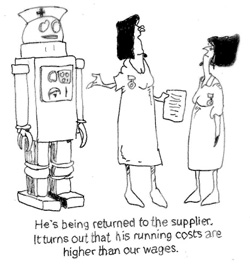Crikey’s business editor Paddy Manning recently published aged care industry data which show that the industry is boosting profits by replacing registered and enrolled nurses with personal care workers.
But one industry leader is calling for even greater slashing of care staff, suggesting that five per cent of the workforce could be replaced by robots and technology. That’s right, soon in a nursing home near you, it’s RoboNurse! No change required in the abbreviation: RN.
Manning’s article highlighted that industry net profits grew by 159% in just one year, rising from $4.14 to $10.71 per resident per day in 2014.
The data came from a Bentley’s survey of 179 aged care providers across Australia and provides rare insight into where Commonwealth subsidies and aged care residents’ fees go in the operation of a nursing home.
On average, nursing homes spent $10.80 per resident per day on food costs and $9.83 on kitchen staff. Head office management expenditure came in at $10.73 per resident per day, which is, as Manning points out, on par with food costs.
The data shows that the top profit-making providers spent 6% less on nursing and care than average providers. These top performers spent $92 per resident per day, compared with $99 at average facilities.
Registered nursing hours dropped over a ten-year period. In 2004, registered nurses spent 5.9 hours with each resident per fortnight, while in 2014 time spent fell to 5.2 hours per fortnight or about 22 minutes per resident over a 24-hour period.
Meanwhile, personal care workers’ time spent with residents was more than triple that of registered nurses, rising from 11.4 hours in 2004 to 16.8 hours in 2014, or 72 minutes per resident per day.
Bear in mind that nursing home residents have higher care needs than ever before. Almost 80 per cent of nursing home residents have complex health care needs and require round-the-clock care. And yet, the industry’s business strategy is to replace skilled nursing staff with cheaper, unskilled care workers.
The CEO of the not-for-profit industry lobby group, Aged and Community Services Australia (ACSA) recently called for greater use of robotics and technology in aged care, arguing that such innovation in aged care could ‘decrease by 5% the amount of people we need’.
ACSA’s views on the future of the aged care workforce are to be spelt out more fully in a document to be released in the coming months.
Although we haven’t seen the full document, the CEO’s comments suggest that ACSA is more concerned with cutting staff than providing quality care.
There is room for technology in aged care, but surely technology cannot replace human beings in care delivery.
Source: Nursing Home Black Box (A blog about the state of nursing homes in Australia by Combined Pensioners & Superannuants Association)



